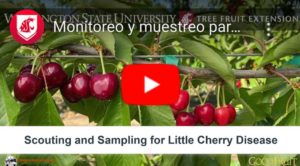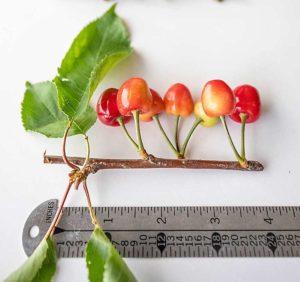This video is also available in Spanish:
There’s no down time after harvest for cherry growers battling little cherry disease.
They urgently need to remove infected trees because there are no treatments available, and infected trees that remain in the orchard are a source for spreading the disease, according to Bernardita Sallato, an extension specialist with Washington State University. Little cherry disease is an umbrella term for the similar symptoms — small, poor tasting, misshaped and unmarketable fruit — caused by two pathogens: the little cherry virus and the X phytoplasma. Both can be vectored by insects and spread via root grafting.
While removing trees that show symptoms is a well understood imperative, it’s less well understood what growers should do next. Some growers are replacing removed trees right away, others are waiting to fumigate and replant entire blocks, while still others are fallowing blocks until there is less disease pressure in the surrounding area.
Sallato, along with colleagues at WSU and Oregon State University, is studying what removal and replant strategies work best in the face of the disease. While results from that effort will be analyzed over the next few years, she met with Good Fruit Grower this spring to share one grower’s approach that seems, anecdotally, to be working well to minimize X disease spread in a Yakima-area block over the past few years.
There will always be a risk to replanting in an orchard with existing X disease pressure in the block or neighboring blocks, Sallato said. But for growers who feel the economic pressure to replant right away, she highlighted strategies to reduce risk:
—Thorough scouting, row by row, just before harvest, to look for the telltale fruit symptoms and flag those trees for removal. In blocks already known to have X disease, WSU now recommends symptomatic trees be removed without confirmation testing.
—Applying herbicide to the symptomatic trees before they are removed to ensure all the roots are killed. This also serves to check for root grafting in the form of herbicide damage in neighboring trees. Any trees that show signs of herbicide damage are also removed in the summer after harvest.
—To ensure the herbicide moves throughout the tree and root system, Sallato recommends temporarily leaving one or two branches, rather than doing a stump cut, so that the tree continues to move that herbicide instead of completely shutting down.
—The next spring, workers replanting in place first dig out any remain roots. They also shovel in fresh dirt when they plant the nursery trees, since there is no way to use pre-plant fumigation in an existing block.
Watch the video below for more details.
—by Kate Prengaman








Leave A Comment